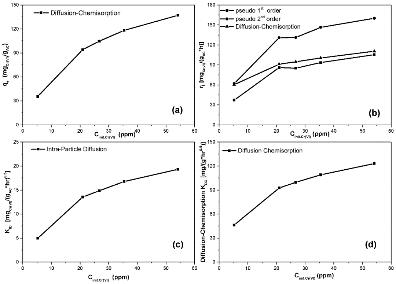|
|
| 咖啡爱好者请注意,喝剩的咖啡渣也可以拯救地球!| MDPI Applied Sciences |
|
论文标题:Nanoporous Activated Carbon Derived via Pyrolysis Process of Spent Coffee: Structural Characterization. Investigation of Its Use for Hexavalent Chromium Removal
期刊:Applied Sciences
作者:Georgios Asimakopoulos, Maria Baikousi, Vasilis Kostas, Marios Papantoniou, Athanasios B. Bourlinos, Radek Zbo?il, Michael A. Karakassides and Constantinos E. Salmas
发表时间:9 December 2020
DOI:10.3390/app10248812
微信链接:
https://mp.weixin.qq.com/s?__biz=MzI1MzEzNjgxMQ==&mid=2649982783&idx=3&sn=
ac050ce6f441c58ac44bc1b3f5b6899d&chksm=f1de3dfbc6a9b4edab74ca515ac941e9b
6d4b20c9a4671ed6770763f4b999b4bc86bf61dee2e&token=287653195&lang=zh_CN#rd
期刊链接:https://www.mdpi.com/journal/applsci
摘要:
通过热解法处理的咖啡残渣可以转化为纳米活性炭,不仅可以有效净化污水中对人体有害的重金属离子,而且相对于传统活性炭的净水方式更加节约成本,绿色安全。本文作者详细描述了使用咖啡渣制备活性炭的实验过程,并就其对溶液中六价铬的去除效率进行了评估。
研究背景:
近年来,在全球循环经济的发展过程中,生物质和生物废弃物越来越多的被用来平衡工业活动对环境污染以及对公众健康的影响。自古埃及时代起,生物提取的活性炭就被用作肥料、燃料,或者用于其他医疗用途。除此之外,活性炭也被应用于许多先进的技术,如催化剂载体、电极材料、空气过滤器和其他存储。自1800年以来,人们逐渐发现活性炭 (AC) 可作为废水处理的吸附剂 [1,2,3,4]。随着纯净资源供应短缺成为人类关心的主要问题之一,全球对活性炭的需求也将会大幅增加,预计2021年会达到5424.9千吨 [5]。利用生物质和生物废弃物生产的活性炭来解决这一问题是十分具有前景的。相较于其他吸附剂,活性炭是应用最为广泛的一种。这是由于它具有优秀的空隙结构,高耐化学性以及多种有机化合物的吸附能力。
六价铬 (Cr(VI)) 被认为是最具毒性的重金属之一,根据世界卫生组织的规定,水中允许的六价铬浓度仅为0.05 ppm [6],而工业废水中的六价铬浓度却高达0.5–270 ppm。科学家们发现通过咖啡渣的热解产出的活性炭在去除废水中六价铬的试验中效果显著 [7–10]。但是传统的处理方法(如化学沉淀法、离子交换法、膜过滤法等)都存在一定的局限性。来自希腊约阿尼纳大学的Georgios Asimakopoulos等人在Applied Sciences期刊上发表的文章提出了生态友好且低成本的全新的处理方式。
研究内容:
Georgios Asimakopoulos等人将从大学咖啡厅收集到的咖啡残渣在80 ℃高温干燥后,在氮气氛围下热解初步制备出咖啡渣活性炭 (AC@SCF) 样本。他们将制备出的活性炭分为七个对照组,每个组将在不同的温度下 (450 ℃、 500 ℃、 550 ℃、 600 ℃、 650 ℃、 700 ℃ 和 800 ℃) 加热2个小时。结果表明,当热解温度大于等于650 ℃时,产物的比表面积和微孔体积分数基本稳定,因此650 ℃为最佳热解温度。将制备好的活性炭样本加入盐酸溶液中搅拌2小时,随后过滤液体,用去离子水将沉淀物洗至中性 (PH = 7),最终将样品在80 ℃下干燥24小时,就可以用来测试样品的六价铬去除能力了。
作者使用氮吸附对材料的结构进行表征,发现在低压范围 (P/P0< 0.01),压差测量迟滞回曲线出现了拐点,而且在P/P0 > 0.1压力范围内吸附氮量增加不明显,这是微孔材料的典型特征。该材料对六价铬的吸附性能良好,最大吸附容量为137 mg Cr(VI)/g AC@SCF。结果表明:AC@SCF的实际比表面积接近2000 m2/g,微孔体积分数接近90%。这可能是其通过吸附过程从从水溶液中高效去除Cr(VI)的主要原因。图1为AC@SCF的扫描电镜 (SEM) 图像 (a,b) 和透射电镜 (TEM) 图像 (c,d) 。从SEM图像来看,该材料具有由直径为1μm的大孔组成的“海绵状”形貌,而TEM图像也显示了微孔的存在。

图1. AC@SCF的扫描电镜 (SEM) 图像 (a,b) 和透射电镜 (TEM) 图像 (c,d) 。
此外,吸附实验结果表明,在溶液pH等于或低于4时,对于初始浓度为7.44 ppm的溶液,六价铬的吸收量为100%;而在pH为6.5时,这一吸收率减少到近17%。这是由于在较低的pH值下,AC@SCF的碳表面由于H+离子的存在而带正电荷,并静电吸引六价铬酸盐阴离子 (HCrO4−、CrO42−和Cr2O72−)。pH值大于4.5时,碳表面带更多负电荷 (由于OH−的存在),铬酸盐阴离子 (HCrO4−、CrO42−)被静电排斥在碳表面,因此吸附效率急剧下降。
作者通过伪一级动力学模型、伪二级动力学模型、粒子内扩散动力学模型和扩散-化学吸附动力学模型等4种不同的动力学模型和5种不同初始Cr(VI)浓度对动力学实验数据进行了解释,得出扩散-化学吸附模型是模拟吸附过程中最为合适的。实验结果中,所有的模型都预测吸附过程的初始速率随着初始Cr(VI)浓度的增加而增加。另外,根据扩散-化学吸附动力学模型拟合得到的实验数据表明,随着溶液初始浓度的增加,吸附速率对扩散机制和化学吸附机制的相关性增大 [11],热力学结果也支持了这一发现。在对热力学研究的中,吉布斯自由能在−20 > δG0 > −80 kJ/mol范围内,这意味着存在物理吸附和化学吸附控制,如离子交换和/或表面络合 [12,13]。

图2. (a) 预测不同初始浓度下AC@SCF上平衡条件下Cr(VI)的最大负载。(b) 用三种不同的动力学模型(除颗粒内扩散模型外)估算不同初始浓度的初始速率。(c) 不同初始浓度的粒内扩散常数。(d) 不同初始浓度的扩散-化学吸附常数。
研究总结:
通过与其他现有吸附剂对Cr(VI)的最大吸附量的比较,AC@SCF的吸附量要高得多 (109 mg/g, 24 h实验值;137 mg/g,pH值为3时平衡阶段的理论预测)。微孔尺寸、微孔体积分数和比表面积是影响AC@SCF吸附剂对Cr(VI)的吸附能力的最重要因素。通过热解咖啡渣制备出的活性炭大比表面积和丰富的微孔结构大大增大了Cr(VI)在有效活性表面位被吸附的概率。作者的研究为未来大规模处理工业污水的工作提出了新的可能性。相较于其他金属和贵重的有机化学物质,咖啡渣制备出的活性炭不但表现出不俗的Cr(VI)吸附能力,且其成本更低,制备过程也更加环保。本研究对环境保护有深远的影响意义,为当今发展趋势的循环经济提供了强大的支持。
参考文献:
1. Hassan, F.M.; Sabri, M.A.; Fazal, H.; Hafeez, A.; Shezad, N.; Hussain, M. Recent trends in activated carbon fibres production from various precursors and applications—A comparative review.J. Anal. Appl. Pyrolysis2020, 145, 104715.
2. Rocha, L.; Pereira, D.; Sousa, É.; Otero, M.; Esteves, V.; Calisto, V. Recent advances on the development and application of magnetic activated carbon and char for the removal of pharmaceutical compounds from waters: A review.Sci. Total Environ.2020, 718, 137272.
3. Heidarinejad, Z.; Dehghani, M.H.; Heidari, M.; Javedan, G.; Ali, I.; Sillanpää, M. Methods for preparation and activation of activated carbon: A review.Environ. Chem. Lett.2020,18, 393–415.4. Jung, W. C., Levesque, J. P. & Ruitenberg, M. J. Semin. Cell Dev. Biol. 61, 60–70 (2017).
4. Januszewicz, K.; Kazimierski, P.; Klein, M.; Karda?, D.; ?uczak, J. Activated Carbon Produced by Pyrolysis of Waste Wood and Straw for Potential Wastewater Adsorption.Materials2020, 13, 2047
5. Activated Carbon Market by Type (Powdered, Granular, Others (Pelletized, Bead)), Application (Liquid Phase (Water Treatment, Foods & Beverages, Pharmaceutical & Medical), Gaseous Phase (Industrial, Automotive)), Region—Global Forecast to Report code CH 4940, January 2017. Available online:https://www.researchandmarkets.com/reports/5143005/activated-carbon-filters-market-by-type(accessed on 28 October 2020).
6. Owlad, M.; Aroua, M.K.; Daud, W.A.W.; Baroutian, S. Removal of Hexavalent Chromium-Contaminated Water and Wastewater: A Review.Water Air Soil Pollut.2009,200, 59–77.
7. Aroua, M.K.; Zuki, F.M.; Sulaiman, N.M. Removal of chromium ions from aqueous solutions by polymer-enhanced ultrafiltration.J. Hazard. Mater.2007,147, 752–758.
8. Babel, S.; Kurniawan, T.A. Cr(VI) removal from synthetic wastewater using coconut shell charcoal and commercial activated carbon modified with oxidizing agents and/or chitosan.Chemosphere2004,54, 951–967
9. Almaguer-Busso, G.; Velasco-Martinez, G.; Aguilera, G.C.; Granados, S.; Torres-Reyes, E.; Alatorre-Ordaz, A. A comparative study of global hexavalent chromium removal by chemical and electrochemical processes.Electrochem. Commun.2009,11, 1097–1100.
10. Chaudhary, A.J.; Goswami, N.C.; Grimes, S.M. Electrolytic removal of hexavalent chromium from aqueous solutions.J. Chem. Technol. Biotechnol.2003,78, 877–883.
11. Sutherland, C. Removal of Heavy Metals from Waters Using Lowcost Adsorbents: Process Development. Ph.D. Thesis, The University of the West Indies, St. Augustine,Trinidad,2004;pp. 150–164.
12. Pholosi, A.; Naidoo, E.B.; Ofomaja, A.E. Intraparticle diffusion of Cr(VI) through biomass and magnetite coated biomass: A comparative kinetic and diffusion study. South Afr.J. Chem. Eng.2020,32, 39–55.
13. Asimakopoulos, G.; Baikousi, M.; Salmas, C.; Bourlinos, A.; Zboril, R.; Karakassides, M. Advanced Cr(VI) sorption properties of activated carbon produced via pyrolysis of the “Posidonia oceanica” seagrass.J. Hazard. Mater.2020, in press.
期刊简介:
Applied Sciences(ISSN 2076–3417, IF2.474) 作为开放获取型国际期刊,主要发表应用自然科学研究领域相关的论文,期刊包括光学和激光、纳米技术和应用纳米科学、能源、材料、化学、机械工程、应用生物科学和生物工程、环境和可持续发展的科学技术和计算与人工智能等24个专题。Applied Sciences采取单盲同行评审,一审平均周期为15.9天,文章从投稿到发表平均仅需35天。
Background:
Hexavalent chromium (Cr(VI)) is a heavy metal that is highly soluble and exhibits toxic effects on biological systems. Nevertheless, it is used in many industrial applications. The adsorption process of Cr(VI), using activated carbon (AC), is under investigation globally. On the other hand, around six million tons of spent coffee is sent to landfill annually. In the spirit of cyclic economy, this research investigated the production of AC from spent coffee for the removal of Cr(VI) from wastewater.
Method:
Activated carbon (AC@SCF) was produced via the pyrolysis process of spent coffee. After drying for 24 h at 80 °C, an amount of 5 g of spent coffee was impregnated with KOH aqueous solution (5 g KOH/100 mL H2O). Seven different samples from the produced sludge were heated up at seven different temperatures (i.e., 450 °C, 500 °C, 550 °C, 600 °C, 650 °C, 700 °C, and 800 °C) and kept at this temperature for 2 h. This heating procedure was carried out under an inert atmosphere (nitrogen flow of 0.2 mL/min) to estimate the optimum temperature for this process. The criterion for this estimation was the specific surface area of the produced AC@SCF. It was observed that, for pyrolysis temperatures equal to or higher than 650 °C, the specific surface area and the micropore volume fraction of the produced AC were almost stable, and the chosen temperature value of 650 °C was the optimum. The pyrolysis process took place in a muffle furnace mounted with a controlling atmosphere system and the temperature increasing rate was 5 °C/min. The cooling process was carried out for 24 h randomly just by switching off the furnace, but always under an inert atmosphere. The produced activated carbon was added to an HCl solution (1 N) and stirred for 2 h. Sequentially, the liquid was filtered and the precipitate was washed with deionized water to a neutral pH of approximately 7. The final material was dried at 80 °C for 24 h and tested for its Cr(VI) removal capacity.
Results:
Chemical activation of spent coffee using KOH as an activation agent led to a highly porous, activated carbon with high surface area and almost a 100% microporous pore structure. Moreover, this process decreased the activation temperature (i.e., 650 °C) compared to that of a physical activation process (i.e., ≥ 900 °C). This material also exhibited excellent sorption properties for hexavalent chromium removal from aqueous solutions, with a maximum uptake capacity of 137 mgCr(VI)/gAC@SCF. According to the porosimetry results, the real specific surface area of the AC@SCF approached the value of 2000 m2/g, while the micropore volume fraction approached the value of 90%. This was probably the main reason for its high performance on Cr(VI) removal from aqueous solutions via the adsorption process. According to the results of adsorption experiments, the maximum Cr(VI) removal capacity was at pH ≤ 4. An optimal pH value of 3 was chosen for carrying out the experiments because it was most promising for achieving stable and economic conditions in a future scaled-up production line. For pH ≥ 4.5, a sharp decrease of the maximum adsorption capacity existed. The interpretation of the kinetic experimental data using four different kinetic models and for five different initial Cr(VI) concentrations resulted in the conclusion that the diffusion–chemisorption model was the most appropriate model for the simulation of the adsorption process. Apart from the statistical criteria, this evidence was also supported by the thermodynamic results where Gibbs free energy was in the range of −20 > ΔG0 > −80 kJ/mol, which meant that both physisorption and chemisorption control, such as ion exchange and/or surface complexation, existed. The thermodynamic study suggested that the adsorption reaction was an endothermic and entry-driven process.
Conclusion:
In conclusion, spent coffee, a waste material which is in abundance globally, could play a significant role as a useful precursor for water treatment to remove toxic hexavalent chromium as well as in different modern applications that require low cost and easily prepared carbon materials with a high surface area.


(来源:科学网)
特别声明:本文转载仅仅是出于传播信息的需要,并不意味着代表本网站观点或证实其内容的真实性;如其他媒体、网站或个人从本网站转载使用,须保留本网站注明的“来源”,并自负版权等法律责任;作者如果不希望被转载或者联系转载稿费等事宜,请与我们接洽。